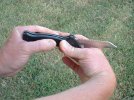No arguing here, I much appreciate the posts from fellow forumites. At first, I was asking why Spyderco used the backlock on most of their models with the S30 steel. I was told, that the backlock was a better, stronger lock, etc. Then I mentioned why did Spyderco use a liner lock on the Military, which also has the S30 premium steel, on a knife recommended for a soldier, (wouldn't the best lock be preferable for war, not combat use, but abuse, dirt, mud, which a soldier may face?) Why did Spyderco choose the liner lock over the "better" backlock?
I was asking for help reasoning with my thoughts.

